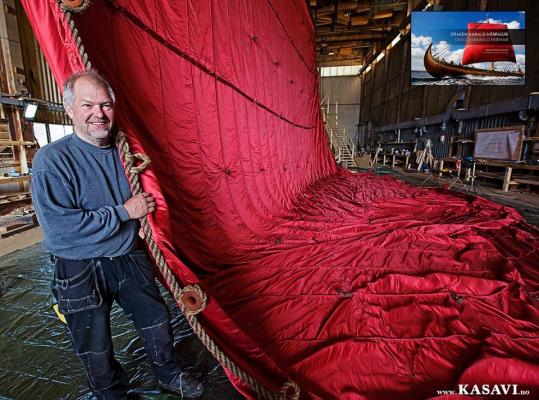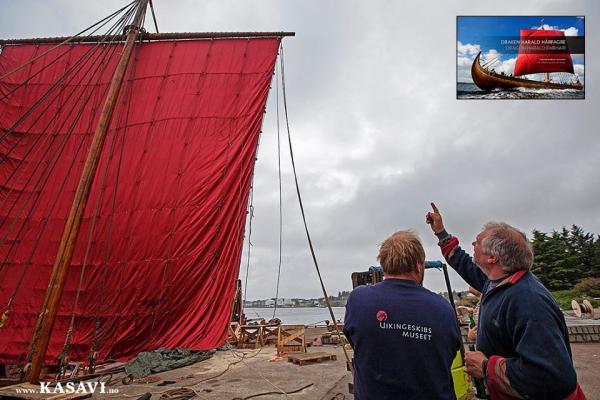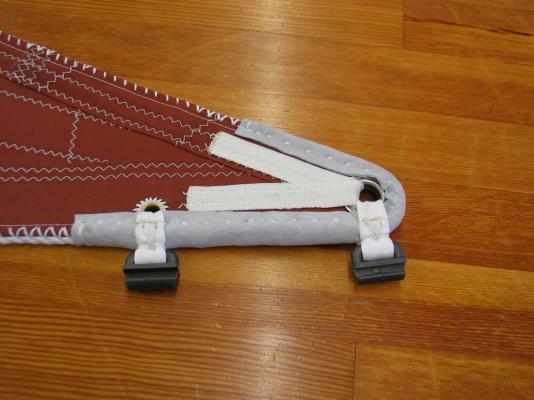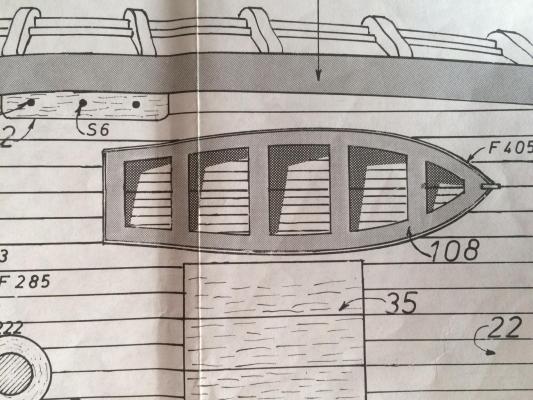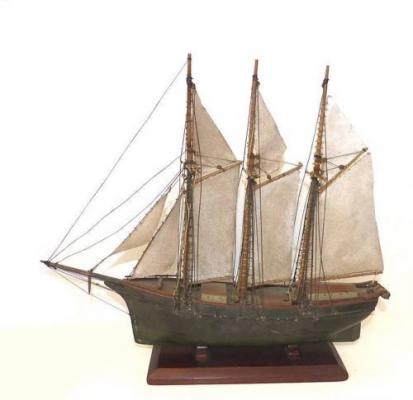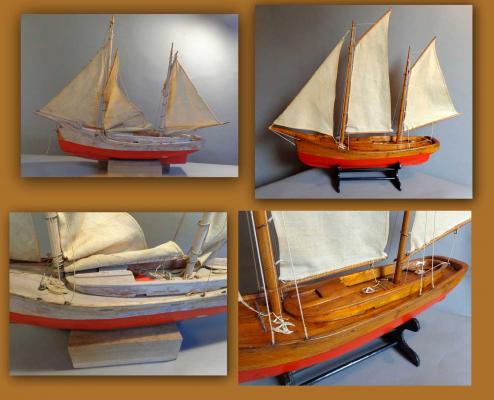
JerseyCity Frankie
Members-
Posts
1,338 -
Joined
-
Last visited
Content Type
Profiles
Forums
Gallery
Events
Everything posted by JerseyCity Frankie
-
I am guessing they would be tarred if there was tackle on them near the masthead? and I will add they likely had baggywrinkle on them too. It may be that the more proper term for them is going to be Quarter Lifts?
-
The second attempt is a vast improvement, congratulations! I struggled massively with the same issue, trying to get the shape of the clewed up canvas to fall into the proper size and shaped arcs and lumps, and I think you did a great job.
-
I may have to amend what I wrote above, I was thinking of the Main Topsail. The Topmast Staysail could be another kettle of fish. I found this discussion though and it has an excellent diagram of the Neufchatel: http://modelshipworld.com/index.php/topic/7842-fitting-of-top-mast-in-a-raking-mast/
-
A good question and I think you DO mean the tacks and not the sheets. I have seen modern schooners do it with a single tack and I have seen them do it with two. The later have to tack up each time they go about and it adds a lot to the workload, but the alternative is resignation to poor sail shape half the time. My GUESS is that a big privateer with a large crew would not mind the extra labor and would want max sail performance and would use two tacks. But this is only my guess.
-
The original question was "What is a good finish for stained planking" and the answer would depend on what planks are in question. If the planks are the deck, no varnish- actual ships did not varnish the decks. But if the question was in regards to planking elsewhere on the ship, the person asking the question should be specific about which planking and on what era the ship dates from. As above, the answer is usually going to be "mat or semi-gloss" but there ARE parts of ships that DO get heavy gloss varnish. These parts of the ship are known as The Brightwork and they typically are the rails skylights wheelboxes and all the rest of the unpainted deck furniture. A good rule of thumb is that if its above the waterline and is not painted and is not the deck and maybe not the anchor stock then it will require regular varnishing and will be as shiny as the sailors can make it.
-
Gift Shop Models, like the one of the schooner pictured above, are ALWAYS coated with heavy gloss varnish. But this should NOT be taken as a good example of any sort of standard of craftsmanship.These models are churned out in third world countries to supply the demand for affordable "hand made" models in gift shops all over the world. The models are built and finished in a way that maximizes their visibility and appeal in a crowded gift shop. Actual ships certainly have their brightwork varnished but I can't think of any actual historic ship that glistens with such a heavy coat of varnish on every surface, including the hull.
-
unidentified incomplete large model ship
JerseyCity Frankie replied to Yakdoc's topic in Wood ship model kits
I would contact an outfit called Grove Pond Yachts in the UK. I am sure you can find their contact info online. From what I have seen of their products and restoration work, I believe they have a comprehensive understanding of the subject. -
How to make tan bark sails
JerseyCity Frankie replied to Jason Builder's topic in Masting, rigging and sails
As a person who has actually used dye on fabric, and who is not merely speculating but rather speaking from experience, I would advise against using commercial fabric dye. You will NEVER get the color you imagine. I have found that it IS possible to mix dye together but the result will likely not conform to your preconceived notions of the results of mixing two dyes. The chemistry of the dye does not conform to the chemistry of paint. So I would recommend Acrylic paint, as mentioned above. You can stain most fabrics with diluted acrylic pain OR you can simply paint a coat of Acrylic over the fabric and achieve the color you want. The color of Acrylic paint you have on your palette WILL be the color you will get on the fabric. Using the dye, you will get SOME SORT of color, and it will be fixed to the fabric in a way that resists repeated washings, but it will not be a color you can predict or control. -
How to make tan bark sails
JerseyCity Frankie replied to Jason Builder's topic in Masting, rigging and sails
I think some of those reading this are confused about what the word "tanbark" means. As mentioned above it is an old fashioned chemical treatment aimed at prolonging the life of the natural fiber sails, which had the effect of turning the sailcloth a distinctive bright red color. Getting back to the original question: Would the sail AND the materials used to make the sail all be the same color? I think it would depend on the size of the sail. I think it is possible the raw canvas was dyed in bulk then assembled into a sail later, and I think its also likely that entire completed sails were dyed after construction. Manmade dacron sailcloth is available in many colors for the modern sailmaker of today and in fact there are multiple shades of "tanbark" on the market, reflecting the fact that actual organic tanbark would fade throughout its life. The people making the reproduction viking longship Drakon Harald have gone back to the old method on at least one of the sails and have dyed the hand woven linen sails they have made using the old fashioned reciie which calls for, as mentioned above, tree bark and ochre. I am including a photo of this sail and a modern dacron sail. -
Wow! I have been wondering if I would buy a case for my Heller Victory, that thing must be a beast! I am sure it looks like a crystal jewel though. Congratulations.
-
My entire Heller Victory build log is focused on the sails. You may find some helpful information on whichever aspects of sail making you are focusing on. I'm not saying the way I made my sails is the best way but I have certainly given the issue a lot of thought.
-
I tried googling and looking on Pinterest ect. But there are no good sources falling easily to hand. odd since if you think about it, the keel of Columbus's boat would have likely been the first European THING to touch the new world. There are a lot of melodramatic depictions of Columbus's shore party wading ashore but there are no real details of the boats and I suspect the illustrators of these pictures hadn't a clue about the boats. Maybe nobody does.
-
I'm tasked with completing a model of the Santa Maria, an old Billing's Boats kit. Plans indicate two ships boats but not any details. Has anyone here got any strong opinions on the hull shapes and construction of these boats? I figured I would ask here on Model Ship World first. I anticipate a lack of contemporary records since the ships themselves are kinda sketchy when it comes to specific documentation. I took a shot of the one-sheet plan I have to work from and this is the only drawing of the boats, there is no elevation. As you can see it is very generic.
-
I find it very helpful to make a large scale drawing of the rigging and I use different colors of ink and pencil to indicate the different elements such as the masts and yards being one color and the standing rigging another with the running rigging yet another color. Make the drawing really large by gluing together a bunch of sheets of paper. The process you have to go through to make the diagram forces you to consider each element as you come to it in the drawing and this often teaches you stuff about the rig you would not have noticed using only the kit supplied diagrams. You dont have to be a skilled draftsman either. You can also measure off the spars on the actual model-or even trace them- to get the sizes of stuff right.
-
Just saw this Joshua Slokum animation: <iframe src="https://player.vimeo.com/video/138939095"width="500" height="281" frameborder="0" webkitallowfullscreen mozallowfullscreen allowfullscreen></iframe> <p><a href=" ">SLOCUM at sea with himself</a> from <a href="https://vimeo.com/fierlingers">Paul and Sandra Fierlinger</a> on <a href="https://vimeo.com">Vimeo</a>.</p>
-
Model Sail maker recommendation? USA
JerseyCity Frankie replied to Jason Builder's topic in Masting, rigging and sails
Sewing is not necessary to make decent model sails. Getting a tanbark color is going to take a trip to a fabric store or the use of some fabric dye or even a dip in some diluted paint. But you can cut the sails with scissors and build up all the details with glued on strips. Check out my HMS Victory build, the link is in my signature, and see how I did my square sails without any actual sewing. -
Rigging the Vasa .... what color goes where?
JerseyCity Frankie replied to RobZorba's topic in Masting, rigging and sails
I find the news that there was no tar used on the Vasa rigging to be a great surprise! Marktledens could you elaborate on what you said about the findings at the Wasa Museum? -
Good point, I never thought it could have been UV radiation.
- 10 replies
-
- finished
- restoration
-
(and 1 more)
Tagged with:
-
Need Help Identifying Grandfather's Ship
JerseyCity Frankie replied to cletusbrandine's topic in Masting, rigging and sails
Nice model. She is a three masted schooner. You can google that term and see hundreds of photos of existing and historic ships that have this very common rig. My advice for the restoration is to use the sails already on the model if you can. If you can not, make templates from the old ones and sew new ones from fabric that is cream colored, not bright white. If the old sails are strong enough, take them off and wash them by hand in a very mild soap solution. and dry them flat on a towel. Make a full size pencil drawing on a big sheet of paper, just trace the profile of the model, and carefully indicate where all the lines come from and go to on the model onto your drawing. Photograph all the details too. Clean the entire model with Q-tips dipped in warm water, two square inches at a time. If the dirt wont budge, work up to stronger solvents starting with more soap, then Alcohol, then Turpentine, then Thinner. Do every square inch on the model, it won't take as long as you may think. You will have some difficulty in finding rigging material that matches the old stuff, and the old stuff is likely too far gone to use. Ask for Carpet or Button Hole thread at a sewing store. I found this photo after searching for "Antique Three Masted Schooner Model". Note that you depend on the titles the uploader used, and they often use the wrong name and in this case in this search there were many photos that were NOT three masted schooners, or even schooners. -
So this job was completed. Never found out why the old varnish was the way it was. I was able to dissolve enough of the old coat to get the wood to look like wood again, then I revarnished.
- 10 replies
-
- finished
- restoration
-
(and 1 more)
Tagged with:
-
Are bolt ropes/earrings served?
JerseyCity Frankie replied to keelhauled's topic in Masting, rigging and sails
Wow that Kipping book is a great resource! Thanks for putting up that link Ed! Hint to all: Scroll to the end of the book, this is where the illustrations are all located. On page 90 it gets into the boltrope and I am going to transcribe here some things: …." The whole length of the FOOT-ROPE, from clue to clue and 15 inches up each leech, is served with small spunyarn : and the length of the foot of the sail measured off. IRON THIMBLES are put into the clue-cringles, and the earings are served with houseline"…. …."Memorandum.-Pieces are pt on at all the corners, and the clues are formed of the bolt-rope, sewed home to the clues, and seized with housline or marline. " …. There is a longer discourse starting on page 67 of the book but I am too lazy to transcribe it. This book is pure gold! Thanks again Ed for showing it to us. -
Are bolt ropes/earrings served?
JerseyCity Frankie replied to keelhauled's topic in Masting, rigging and sails
I just deleted some speculations I made after reading some of the link Ed posted above. Admins can delete this post of mine if they like. -
What is a score block ?
JerseyCity Frankie replied to captainbob's topic in Masting, rigging and sails
I find the drawing confusing, what are we looking at? At first I thought the diagonal spar pointing to the upper right to the drawing was a Gaff. But looking at the mast on the left of the drawing I see what appear to be a Spring Stay on the Left and Headsails indicated on stays to the right. So what is our spar doing there on the right, forward of the Mast? Is it some sort of derrick?
About us
Modelshipworld - Advancing Ship Modeling through Research
SSL Secured
Your security is important for us so this Website is SSL-Secured
NRG Mailing Address
Nautical Research Guild
237 South Lincoln Street
Westmont IL, 60559-1917
Model Ship World ® and the MSW logo are Registered Trademarks, and belong to the Nautical Research Guild (United States Patent and Trademark Office: No. 6,929,264 & No. 6,929,274, registered Dec. 20, 2022)
Helpful Links
About the NRG
If you enjoy building ship models that are historically accurate as well as beautiful, then The Nautical Research Guild (NRG) is just right for you.
The Guild is a non-profit educational organization whose mission is to “Advance Ship Modeling Through Research”. We provide support to our members in their efforts to raise the quality of their model ships.
The Nautical Research Guild has published our world-renowned quarterly magazine, The Nautical Research Journal, since 1955. The pages of the Journal are full of articles by accomplished ship modelers who show you how they create those exquisite details on their models, and by maritime historians who show you the correct details to build. The Journal is available in both print and digital editions. Go to the NRG web site (www.thenrg.org) to download a complimentary digital copy of the Journal. The NRG also publishes plan sets, books and compilations of back issues of the Journal and the former Ships in Scale and Model Ship Builder magazines.


